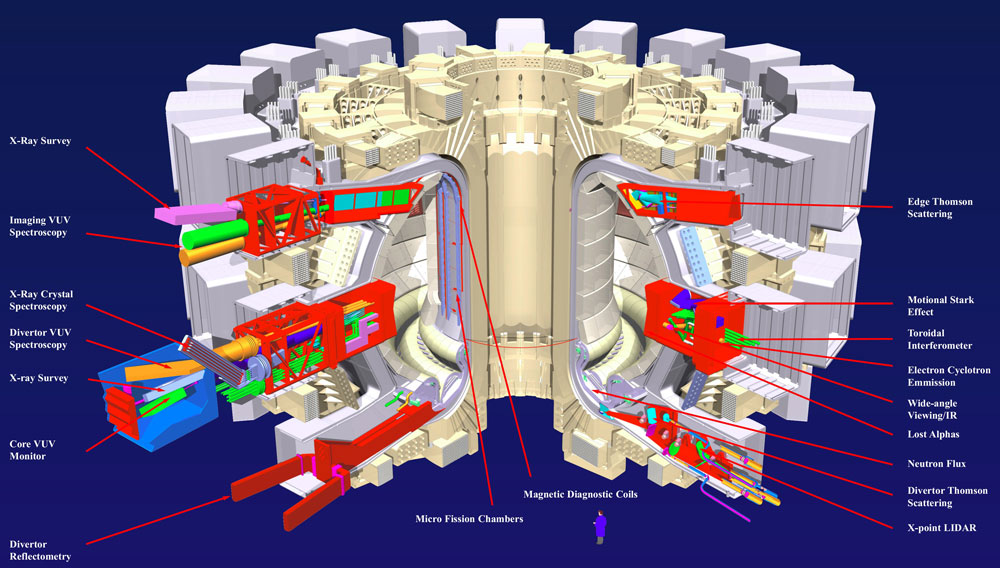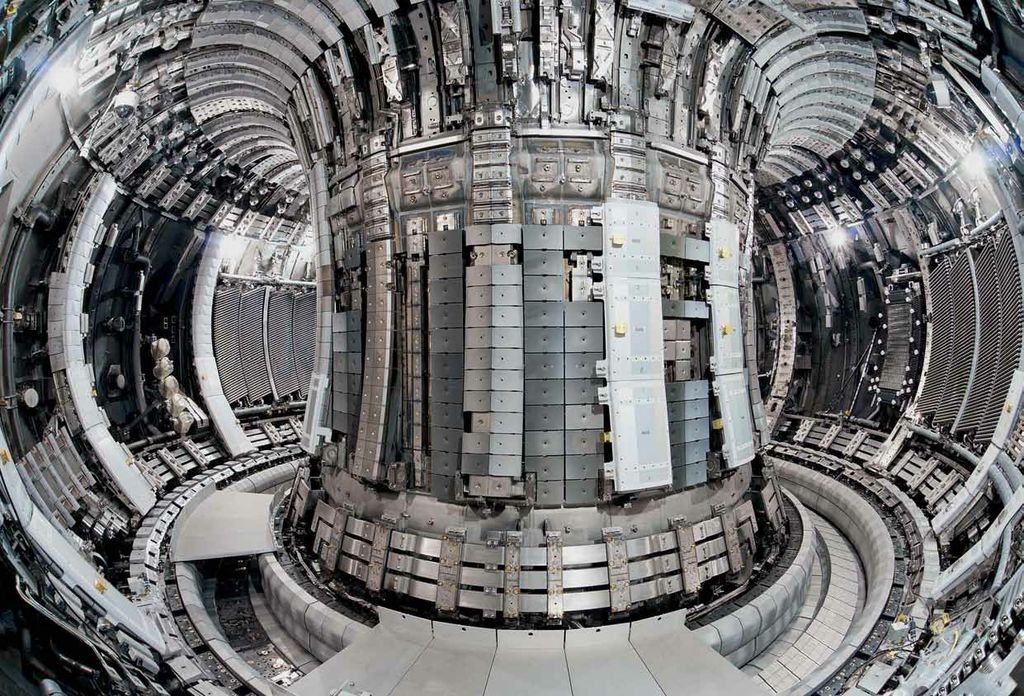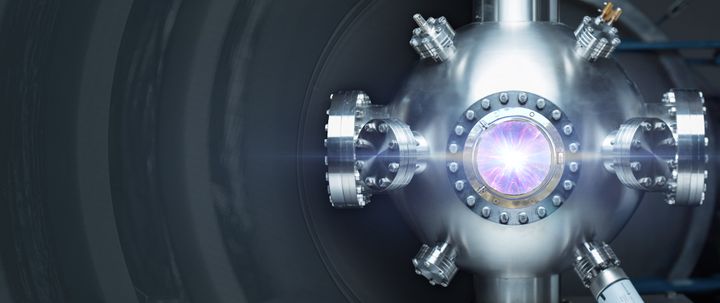
Fusion power has taken a beating in the last few decades. Once considered the best candidate for clean, abundant energy and an alternative to fossil fuel and coal, a succession of failed experiments led many to conclude that it was a pipe dream - or at least, still many decades away from being realized. However, research by national laboratories and private companies have yielded some positive results in recent years, leading some to believe that the era of cold fusion may be just around the corner.
Consider Lockheed-Martin's proposed Compact Fusion Reactor (CFT), a project that a small team of scientists have been working on for years at the company’s secretive Skunk Works in Palmdale, California. On October 16th, the company decided to go public with their plan to develop cold fusion, and indicated that it was seeking a scientific team and parnters to make that happen.
To develop their CFT concept, the Skunk Works facility built on more than 60 years of fusion research and investment and created an approach that offers a significant reduction in size compared to mainstream efforts.
“Our compact fusion concept combines several alternative magnetic confinement approaches, taking the best parts of each, and offers a 90 percent size reduction over previous concepts,” said Tom McGuire, the compact fusion lead for the Skunk Works’ Revolutionary Technology Programs. “The smaller size will allow us to design, build and test the CFR in less than a year.”

The company says that its innovative method for confining the superhot ionized gas, or plasma, necessary for fusion means that it can make a working reactor 1/10 the size of current efforts, such as the international ITER fusion project under construction in France. Being able to build such a small and presumably cheap reactor would be world-changing - compared to ITER, which will cost at least $20 billion to build and will only prove the principle, not generate any electricity.
McGuire said that their magnetic confinement concept combined elements from several earlier approaches. These included a cusp confinement in the core which is encapsulated by magnetic mirrors to restrict particles from movement along its axis and prevents them from escaping.
Another technique the team is using to counter particle losses from cusp confinement is recirculation: “We recapture the flow of particles and route it back into the device,” McGuire said.
The team has built its first machine and has carried out 200 shots during commissioning and applied up to 1 kilowatt of heating, but McGuire declined to provide measurements of plasma temperature, density, or confinement time - the key parameters for a fusion plasma. He did say however that the plasma appeared very stable during the course of their experiments.
McGuire also said that he and his team would be ramping up heating over the coming months and will be publish results next year. The Lockheed team predicts that it will take 5 years to prove the concept for the new reactor. After that, they estimate it will take another 5 years to build a prototype that could produce 100 megawatts (MW) of electricity - enough for a small city - but which could still fit on the back of a truck.
With little real information, no one is prepared to say that Lockheed’s approach is going to spark a revolution. “You can’t conclude anything from this,” says Steven Cowley, director of the Culham Centre for Fusion Energy in Abingdon, U.K. “If it wasn’t Lockheed Martin, you’d say it was probably a bunch of crazies.”
Nevertheless, Lockheed-Martin is confident that its efforts will bear fruit. Speaking at a press conference that took place this past Monday (Oct. 20th) at the company’s facility in Palmdale, California, Tom McGuire defended the project’s scientific merits: “We think we’ve invented something that is inherently stable,” he told reporters. But he acknowledged that “we are very early in the scientific process.”
McGuire said furhter that he has been working with a team of five to 10 people for the past 4 years and hopes to expand the team now that the project is in the open.
And regardless of whether Lockheed Martin is successufl, this is just one of several reported breakthroughs in the past few years. Earlier this month, Andrea Rossi’s E-Cat - the device that purports to use cold fusion to generate massive amounts of cheap, clean energy - was apparently verified by third-party researchers
According to a 54-page report, which was compiled by six reputable researchers from Italy and Sweden, a small E-Cat device was observed over a period of 32 days. During that time, it produced a net energy of 1.5 megawatt-hours, or “far more than can be obtained from any known chemical sources in the small reactor volume.”
The researchers were also allowed to analyze the fuel before and after the 32-day run, noting that the isotopes in the spent fuel could only have been obtained by “nuclear reactions”. This conclusion boggled the researchers, who said further that: “It is of course very hard to comprehend how these fusion processes can take place in the fuel compound at low energies.”
Very hard would be accurate, since this works out to an energy density one-million times that of the same volume of gasoline. Nevertheless, the conclusions appear to be sincere. This is the second time that a third-party verfication has been conducted for the E-Cat. The first, published in March of 2013, was debunked rather rapidly. Hence why this report was intentionally designed to avoid any potential oversights or logical leaps.
The research has also been submitted to the Arxiv pre-print server, with the hope of eventually being published in the Journal of Nuclear Physics.

And then there is the Joint European Torus experiment located in Oxfordshire, England. Since it first became operational in 1997, it has held the world record for fusion reactor efficiency.
But more important is the fact that it is expected to be the first cold fusion power experiment to reach the "break-even" point - the point where the energy required to start a fusion reaction is the same as that generated by it - in the next few years.
Should it prove successful, then the ITER facily should have no trouble obtaining the holy grail of everlasting green power generation: self-sustaining fusion.
Similarly, the National Ignition Facility (NIF) in Livermore, California reported in September of 2013 that they had created a fusion reaction where the amount of energy released exceeded the amount of energy being absorbed by the fuel. This was the first time this had been achieved at any fusion facility anywhere in the world.
Whereas reactors like ITER, JET and the CFT rely on magnetic confinement to cause a fusion reaction, the NIF uses 192 beams from the world's most powerful laser to heat and compress a small pellet of hydrogen fuel to the point where nuclear fusion reactions take place. Thus, this achievement was diluted by the fact that this ignition method requires 500 terrawatts of laser power, which is rather inefficient.
Nevertheless, this too was a developmental milestone, and a watershed moment in the history of fusion research. At this rate, who knows what will be possible within five to ten years? Miniature fusion reactors? Self-sustaining fusion power? Cities running on clean energy? Rockets running on fusion reactors? The dream continues...
- news.sciencemag.org/physics/2014/10/lockheed-looks-partners-its-proposed-fusion-reactor-0
- www.lockheedmartin.com/us/news/press-releases/2014/october/141015ae_lockheed-martin-pursuing-compact-nuclear-fusion.html
- www.cbc.ca/news/business/fusion-reactors-still-10-years-out-as-lockheed-martin-announces-breakthrough-1.2804036
- www.iter.org/mach
- www.extremetech.com/extreme/191754-cold-fusion-reactor-verified-by-third-party-researchers-seems-to-have-1-million-times-the-energy-density-of-gasoline
- www.bbc.co.uk/news/science-environment-24429621
- www.extremetech.com/extreme/181298-the-uk-will-be-the-first-to-break-even-with-fusion-power-leading-us-towards-a-future-of-clean-infinite-energy








